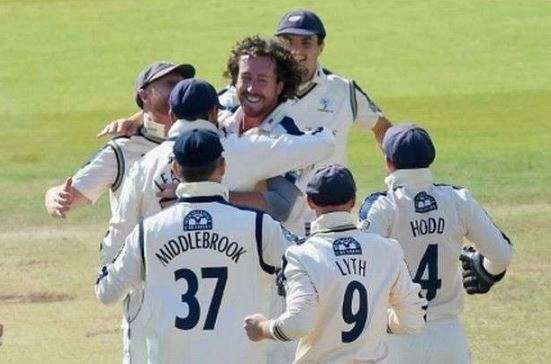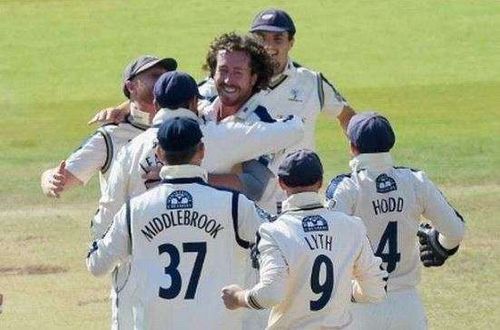
Declaration bowling - How Yorkshire's strategy to play their worst cricket brought about a thrilling finale

If you happened to be at Lord’s to witness the final day’s action of this season’s County Championship on Friday morning, you would have been faced with a very curious sight. Loopy off breaks and leg breaks, long hops and slow balls were being smashed to all parts of the ground. The batting team’s scoring rate for almost an hour was close to 15 runs per over. While the Middlesex middle order was unleashing a run feast seldom seen in the longest format of the game, bowling at the two ends were Adam Lyth and Alex Lees – better known as two of the best opening batsmen in England.
Contrary to evidence, this was not a village cricket match in progress. Nor was this an inconsequential match with nothing on the line and no crowds to entertain – this was the winner-take-all virtual final of the entire season, being played between Middlesex and Yorkshire, two of the biggest county sides in the country.
Because of the added attention on the match, there was also added incredulity at what was unfolding. Some felt that what was happening was a terrible advertisement for the game. A whisper that the match had been ‘fixed’ was heard echoing in the hallowed corridors of the too-oft alluded to spirit of cricket.
For some fans, it was unfathomable how a side’s worst bowlers were used at such a crucial juncture of such a crucial match. Before Lyth and Lees had come on to bowl, Middlesex were leading by about 150 runs on the final day of the match, with 7 wickets in hand, and Yorkshire still to bat.
However, it is exactly this that separates the glorious game of cricket from all other sports – the ‘spirit of (this) game’ is something that is so vast that the possibilities it entails are sometimes almost inconceivable. What was happening at Lord’s on Friday is called ‘declaration bowling’, one of the many curious eccentricities which cricket accommodates.
The more hardened cricket fan will recall that it is this eccentricity of the game that had allowed a shamefaced Tom Moody to race to a 26-minute century for Worcester and for Nasser Hussain to pick up the wicket of Viv Richards, among other such instances. More importantly, this is a strategy that has been used many times over the years to achieve results in matches and entertain crowds in the process.
The unique circumstances of declaration bowling
Declaration bowling isn't really a bad advertisement or contrary to the spirit of the game. It is a perfect advertisement of how human the game of cricket is.
Some critics of what happened on Friday have pointed to the fact that declaration bowling has been outlawed in recent years. Firstly, this is erroneous because it has been outlawed only for a specific scenario. And secondly, the majority of all great things are accomplished in both life and cricket despite the existence of laws, and not because of them.
For a complete appreciation of this brilliant tactic, it is vital to know the circumstances in which it is used. A cricket ball is what it is because of all that has gone before it and all that is to come after it. The last ball of the 46th over of an ODI demands a certain conduct, while the last ball of an evening session demands an approach entirely different. Given the position Middlesex and Yorkshire found themselves in on the final day of their match, the conduct that made the most sense was the tomfoolery that seemed to be happening off Lyth and Lees’ bowling.
The County Championship had come down to a three-way race between Somerset, Middlesex and Yorkshire. With Somerset’s match ending in a win, the equation was like this – if a result was achieved in the match between Middlesex and Yorkshire, the winner would finish the season in first place; but if their game ended in a draw, Somerset would be crowned champions.
With only 22 wickets falling on the first three days of their match, and 18 left to fall on the final day, a draw seemed imminent. A small council must have been held somewhere, and a decision was taken that Yorkshire would bowl as badly as they could. Outgoing coach Jason Gillespie was involved in the decision, as can be seen with the conviction with which he has defended this strategy on social media after countless attacks.
Middlesex raced to a 240-run lead, a score that Yorkshire needed to chase down in the 40 overs remaining in the match. This is what the whole season’s work had come down to – a heart-stopping 40-over chase with a required run rate of 6. Almost like the maddening final lap of a 10,000-metre sprint.
Most thrilling County final in recent memory
Yorkshire batted aggressively, but eventually fell short by 61 runs, losing all their wickets with 4.4 overs still left to play. With 37 balls left in the match, Yorkshire needed 68 runs to win, but crucially were six wickets down. The possibility of a draw loomed again, and 160 miles away, Somerset dared to dream again. That is, until a hat-trick by Middlesex bowler Toby Roland-Jones ensured that his team won the four-day title for the first time since 1993.
Without a shred of a doubt, this was the most thrilling finish to a County Championship season in recent memory.
Yorkshire captain Andrew Gale said after the match, “I never thought our declaration was generous. Just unlucky to be on the wrong side of the result. We hoped one of our batsmen would go on to make a big score but that was not to be.”
There is no other sport where doing badly on purpose can be thought to be beneficial. This is yet another beautiful dimension to a sport that is filled with glorious oddities and unpredictable complexities, and we are all the richer for it.
If there is any critic of declaration bowling, he is either a Somerset fan or someone with a limited grasp of how cricket works.
